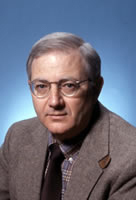
After more than 100 years of work on the ground, aerospace engineering research has taken flight.
Earlier this fall, two Cessna Citations engaged by faculty from the aero-optics project in the Center for Flow Physics and Control at the University of Notre Dame began the initial flight experimentation in a five-year project supported by a $5.6 million U.S. Air Force grant.
During the course of the project, the high-speed jets will be outfitted as sophisticated airborne aero-optics laboratories that initiate laser movement between aircraft and record and analyze those contacts.
The project represents Notre Dames first foray into flight-test engineering, which is common in industry but rare at the university level, according to Stephen Batill, chair and professor of aerospace and mechanical engineering (AME).
It is an essential step to further the pioneering aero-optics research of a group assembled by Eric Jumper, AME professor and lead researcher on the project.
The aero-optic groups mission is to understand how the turbulence around an aircraft affects light and laser transmissions, and how turbulence-imposed distortions can be corrected. The work is expected to pave the way for speed-of-light, free-space communications that might occur between aircraft, between an aircraft and the ground, or between an aircraft and a satellite. Among practical applications, imagine high-speed Internet service during a commercial airline flight.
The Center for Flow Physics and Control, directed by Thomas Corke, was itself established to promote multi- and interdisciplinary research in the areas of flow diagnostics, prediction, and control. Jumpers teamincluding research assistant professor Stanislav Gordeyev, visiting professor Mark Rennie, research specialist Dave Cavalieri, operations manager Mike Zenk and several graduate studentsprovides everything from the experimental and safety protocols of flight tests to analysis of the underlying principals of physics and Computational Fluid Dynamics (CFD). Meng Wang, associate professor of AME, and his group of computational experts are working with the aero-optics group on the CFD calculations.
Creating a flight-test program is difficult and involves a good bit of internal and external partnership, Batill said.
A new, larger wind tunnel facility being constructed on the north side of the Notre Dame campus includes elements that are particularly beneficial to aero-optics research, according to Corke. The wind tunnel produces the conditions expected in the flight simulations.
Besides Notre Dame faculty and equipment, and Air Force funding, Jumper has assembled external partners from industry. Boeing, for example, will build pieces of the aircraft testing device. A southwestern Michigan flight service has been signed on to provide the aircraft and flight time.
Project members face a weighty to-do list over the next five years: Conceive and predict flow-control schemes and test them both in the wind tunnel and in flight; design a turret-like laser trapping device for the air experiments that captures and analyzes data; design two-aircraft send-and-receive experiments at flight speeds close to the speed of sound.
But the very point of the in-air investigation, says Jumper, is to reverse a shortfall.
No flight tests have been flown to see if the predictions based on theory and wind-tunnel testing can be validated,he said.
What is known: Light beams seem to survive fairly well if they are directed straight forward. Its when they are sent and received fromthe full hemispheres above and below the aircraftthat they become distorted, Jumper said.
TopicID: 25746